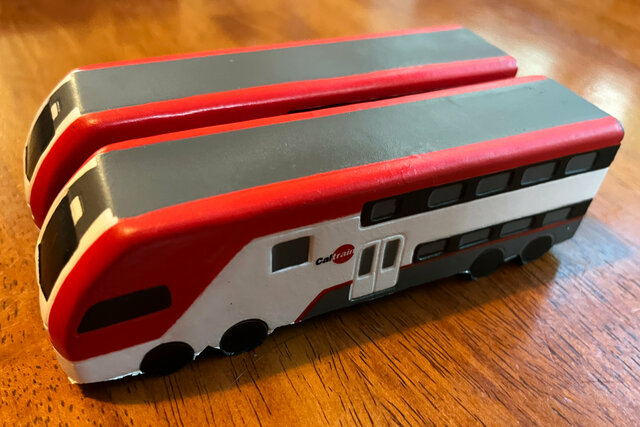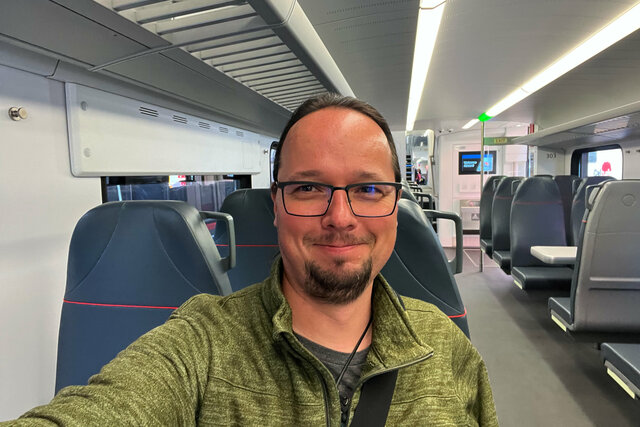EMU
Started: 2023-09-25 21:00:05
Submitted: 2023-09-25 23:26:55
Visibility: World-readable
An electric train tour
Caltrain is nearing completion on a multi-year project to electrify their track from San Francisco to San Jose. To promote their effort the held a public tour of their new electric rolling stock at their terminal station in San Francisco.
It seemed appropriate to take Caltrain itself to see the Caltrain event in San Francisco. The current weekend service pattern is hourly all-stations stopping service, taking 100 minutes from San Jose's Diridon Station to San Francisco's terminus. We departed Santa Cruz with what should have been enough time to drive to San Jose (my closest Caltrain station), but we ran into traffic traffic on highway 17 (based on the damage to the cars I saw, it looked like a head-on collision at an unprotected left turn onto or off of Glenwood Cutoff; this is why I refused to look at any houses with left turns onto or off of highway 17). By the time we cleared the accident-related slowdown we could no longer make it to San Jose in time to catch the train. But the all-stations stopping service took long enough to travel northward that we caught up to the train in Mountain View, where the Caltrain station is conveniently located next to highway 85.
We arrived in San Francisco at noon, a few minutes behind the timetable. The block of Townsend Street, just north of the station, had been blocked off for the event, with a line for the the train tour itself, a stage with a DJ, a merch tent, booths for various transit agencies and infrastructure projects, food trucks, and restrooms. The line for the train was empty; we walked right in with our timed reservation in the 12:00 hour, and walked into the station and onto the platform to visit the new trains.
They had parked two EMU trainsets next to each other on adjacent tracks, set up so visitors could walk to the end of the platform, enter the train, and walk back to the front of the train. The position of the train on the long narrow platform, next to the existing passenger carriages, meant that it was hard to get a good picture of the whole train, but I'd like to think that I got some reasonable pictures of the train we visited.
At the end of the platform, just as we were about to enter the train, event staff gave us squishy toys in the colors and style of the new Caltrain driving cab EMU units.
We stepped into the train onto the lower level of the double-decker train cars and began to walk back to the front of the train. The whole thing was shiny and new, but it was clearly designed on the same principles as the existing Caltrain fleet, with large bike areas on the lower level of some of the carriages, equipped with cords to hold bikes in place and instructions for how to order bikes by stop, following Caltrain's existing guidelines for bringing bikes on trains.
Inside the train were event staff representing various agencies involved in the trains. Many wore Stadler jackets, representing the Swiss manufacturer of the train. (One person I talked to worked for Samtrans.) One of the Stadler employees worked in manufacturing in the Salt Lake City factory; he built the assemblies around the doors, and flew into San Francisco for the event this weekend. Another Stadler employee worked in something like integration testing and acceptance in San Jose, working specifically with Caltrain on this project.
The most interesting Stadler employee was stationed at the front of the train, next to the window looking into the driving cab. He was a TPM (technical project manager, or technical program manager), so he spends his days wrangling engineers to do their jobs, based in Salt Lake City. Among the things I learned:
- These trains are designed to accelerate at 1.0 m/s². Normal acceleration for passenger service is between 0.9 and 1.3 m/s². Lower acceleration means the trains won't get up to speed fast enough; higher acceleration means it's harder to stand in the train. (Caltrain is intended as commuter rail service where everyone ought to get a seat, but there's plenty of space for standing if necessary, and some jumpseats in otherwise-weird places on the walls.)
- The trains are designed with a maximum speed of 110 mph. (He kept doing the conversion back and forth between kph and mph to make sure he got the right numbers.) But on Caltrain's current track, service will be limited by the current track speed limit of 79 mph.
- These trains are adapted from Stadler's KISS train platform, which is currently in service in a bunch of countries for a bunch of agencies. (Among the complications of some of these agencies is support for multiple overhead voltages; at least Caltrain is building its electrification from the ground up so they can standardize on 25 kV up front.)
- The train platform normally has elevated doors designed for high platforms, but Caltrain currently has low platforms that board onto the lower level of the double-decker train. The trains are delivered with the upper doors replaced by door plugs with an emergency exit in the window and a couple of jumpseats forming an awkward seating area in what's supposed to be the train's entry vestibule. (There are sensors built into the ceiling above the door plugs designed to count passengers entering and exiting the train.) This vestibule is shown below, with the window to the driving cab to the left.
I looked into the window into the driving cab to see where the engineer drives the train. (I forgot to ask about signaling and safety systems, but I probably spent enough time talking to the TPM so I should give someone else a chance to talk.)
I asked the TPM what he thought was the most interesting thing about the train and he took me up the half-flight of stairs to the upper level and pointed out the upper profile of the passenger cab: the corners of the carriage are fairly high, based on the loading gauge imposed by Caltrain's tracks; trains built for European tracks have a smaller dynamic envelope and have to curve lower and more aggressively, cutting off more of the head space in the window seats.
Before I left the train I dropped down to the lower level to get a selfie sitting in one of the seats. (The rest of my family had abandoned me while I was talking to the TPM about speed limits.)
I stepped out onto the platform and saw the difference between the lower doors (and the step that folded out from the edge of the train to partially cover the gap between the lower level of the train and Caltrain's very low platforms).
Julian was willing to take a picture with me at the front of the train — a train I hope to ride next fall when it enters revenue service at last.
San Jose to San Francisco is 46 miles by train. At the current track speed limits, a nonstop train could make the journey in about about 39 minutes (ignoring acceleration and deceleration). If the track were improved to allow a uniform 79 mph speed limit along the entire corridor, the non-stop journey could be done in 35 minutes. If the track were improved to allow the new rolling stock to cruise at its maximum speed of 110 mph (which would involve a massive infrastructure investment in grade-separating the entire line to avoid any possibility whatsoever of interactions between cars and trains at grade), the non-stop journey could be completed in just 25 minutes.
The best time to have built rail infrastructure was 20 years ago. The next best time is now, so it'll be ready when we need it in the future.
We exited the train tour and ate lunch at a Greek-fusion food truck parked on Townsend Street. (Calvin and I ate burritos filled with falafel and hummus; Kiesa and Julian at falafel sliders, though Julian inexplicably dislikes melted cheese so he ate less of his than he otherwise might have.)
I looked at the booths promoting various transit agencies and transit projects, including California's Central Valley high-speed rail project (I'm torn between calling it a boondoggle and a completely necessary boondoggle; it was a bit of strategic political economy to start the train in the Central Valley so they had a bunch of sunk costs to leverage in case funding is threatened) and the rail extension into the empty station box under Salesforce Transit Center (which might be mostly funded, though they keep value-engineering it by killing useful features like the direct connection to the Market Street Subway). The Caltrain booth had a model of an EMU trainset that showed doors in both the lower and higher positions.
Caltrain had a poster presenting their proposed service plan for fall 2024, focusing on 4 trains per hour during peak weekday commute hours. I pointed out to the guy standing behind the poster that we were here on a weekend and it'd be great to get good weekend and evening service as well.
The event was wrapping up as we approached 14:00 (and I missed my chance to visit the merch tent so I couldn't get a t-shirt showing the rolling stock used on the peninsula over the past 150 years), but we missed the train leaving at 13:58 so we had to wait another hour to get the next hourly train. We walked to Room&Board's showroom, across Townsend Street at the end of the Caltrain yard, and looked around the furniture for a few minutes (Kiesa found an adjustable-height endtable she'd seen on Craigslist) before heading back to the station to catch our train down the peninsula.
Our route down the platform to our train took us past the new EMU driving cabs, parked on the platforms next to the existing diesel stock.
We rode the local train down the peninsula to Mountain View, then drove the rest of the way home over the mountain to Santa Cruz.
I have a few more pictures of the electric train tour at Photos on 2023-09-23.
















